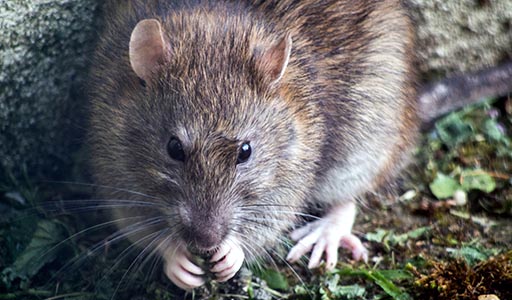Rats

Rat Information
No animal inspires revulsion in humans quite so much as the rat. All throughout history, rats have been considered bearers of deadly diseases, and with good reason—they are known to spread more than 35 diseases, including the bubonic plague.
Rats are medium-sized rodents with long, hairless tails, of which there are 56 known species in the world. In North America, the three rat species you are most likely to encounter are the Norway rat (aka brown rat), the roof rat (aka ship rat, black rat), and the pack rat (aka woodrat).
Rats leave tracks that vary from about one-half to one inch in length and width depending on the individual pests’ age, size, and sex.
By far the commonest rat in the US, and probably what springs to mind when you hear the word “rat,” is the Norway rat.
Less common, but still far from scarce, is the roof rat, which typically lives in coastal and tropical climates, although they can adapt to colder weather.
The pack rat thrives in the deserts of the southwest and Mexico. They are referred to as “pack rats” because they are fond of small, shiny objects, which they will readily run off with.
Perhaps the most distinctive feature of rats is their long, hairless tails. These tails have several functions. Their primary function is thermoregulation; since rats cannot sweat, their tails are a perfect heat-loss organ. They are also instrumental in rats’ ability to keep their balance. So while they may not look like it, a rat’s tail is a nice little piece of engineering.

Rat Appearance
While all rats are medium-sized rodents with hairless tails that are nearly as long as the body itself, there are a few differences among North America’s commonest rat species:
Norway rats are large, growing to around 16 inches long (tail included—their bodies are around 9.5 inches), with males typically weighing around 1.25 pounds. Of course, like any species, every so often a giant crops up. Norway rats have brownish-grey coats, blunt noses, and small bald ears.
Roof rats are smaller than Norway rats, but usually have a significantly longer tail—the body length of a roof rat is 6-8 inches, with their tails surpassing their body length at 7-10 inches. Roof rats have black fur with pale underbellies, and large eyes and ears.
Pack rats are on the smaller side, with a length of 12-19 inches (including the tail), and with adult males weighing anything from 11-21 ounces. Pack rats are thought to have a distinctively “rat-like” appearance, with long tails, large ears, and large black eyes.

Rat Diet
Rats are omnivorous foragers. While rats are fairly opportunistic feeders that won’t pass on a free meal, they do have their preferences. In the wild, rats tend to eat fruit, nuts, seeds, and vegetable. However, the diet of a rat appears to be somewhat dependent on the species. Norway rats, for example, are omnivorous but prefer a carnivorous diet consisting of shrimp, snails, insects, mussels, and bird eggs, while roof rats and pack rats—while also omnivores—prefer grains and cereals. When they do eat meat, rats prefer obtaining it by scavenging carcasses or digging through garbage bins than actually hunting. As is typical of pests, rats often pilfer food from human food sources. For example, in addition to their preferred grains and seeds, rats can make a meal out of vegetable gardens, fallen fruit, pet food, compost and even garbage. Sometimes rats will even eat their own feces, since their digestive system is such that they often “miss” the absorption of a large amount of nutrients on the first go-round. So, while rats can be accused of being many things, being wasteful shouldn’t be among them!

Rat Habitats
Norway rats are thought to have originated in the plains of Asia, Northern China and Mongolia. Starting in the Middle Ages, they spread to Europe, and can now be found pretty much anywhere in the world, especially in large urban areas such as New York City, where they usually live in burrows at ground or basement level.
Black rats have had a similar distribution, originating in India and Southeast Asia, then spreading to the Near East and Egypt, and eventually reaching Great Britain, at which point Europeans spread them worldwide. The black rat is largely confined to warmer areas, having been supplanted by the Norway rat in both cooler regions and urban centers. This occurred not only because Norway rats are larger and more aggressive, but because humans’ shift from wooden structures and thatched roofs to bricked and tiled building favored the burrowing Norway rats over the arboreal black rats.
Pack rats live anywhere from low, hot, dry deserts to cold, rocky slopes above the timberline. Pack rats are prolific builders and construct nests or dens made of twigs, cactus joints, and other materials. These dens are often quite complex and contain several nest chambers, food caches, and debris piles.

Rat Breeding
Generally, male rats reach sexual maturity at 10-12 weeks of age, although females may have their first estrus as early as 8-9 weeks of age. Rats are polyestrous and breed throughout the year, usually at night. Females can produce up to five litters a year, and the gestation period for Norway rats is only 21 days. Litters can number up to 14. This means that under ideal conditions, the population of females could increase by a factor of three and a half in eight weeks, corresponding to a population growing by a factor of 10 in just 15 weeks. Therefore, a rat population can grow from 2 to 15,000 in just one year! When mating, male rats can ejaculate multiple times in a row, which increases the likelihood of pregnancy. Multiple ejaculation also means that males can mate with several females in a short span of time. Interestingly, in mating, female rats display a clear preference for unknown males than for males that they have already mated with. Females also prefer mating with males that have not experience social stress during adolescence, and can determine which males experienced social stress during adolescence even when there is no observed difference in sexual performance between males experiencing social stress in adolescence and not.
Rats are some of the most exasperating animals to take up residence in your home, mainly due to their destructive capacity, the diseases they carry, and the staggering rate at which they breed. Perhaps the best deterrent for rats is simple cleanliness. Rodents enter your house for three reasons: food, water, and shelter. Any step you take to deprive them of these basic needs is a step in the right direction.
These are particularly effective:

Seal gaps
Rats and mice have a real talent for squeezing in tight gaps, so seal any gaps with wire wool (which is difficult for rodents to chew through), caulk, metal kick plates or cement.

Declutter
Rats and mice have a real talent for squeezing in tight gaps, so seal any gaps with wire wool (which is difficult for rodents to chew through), caulk, metal kick plates or cement.

Eliminate Food Sources
Many homeowners make it too easy for rodents by leaving food, especially pet food, out in the open for these opportunistic creatures to feast on. Store food in sealed containers, and if you have birdfeeders, consider moving them further away from the house or even taking them down completely until the issue has been dealt with.
While the above methods can be effective in preventing rats, they can carry many diseases, and infestations can set in in the blink of an eye. They might be too formidable for the average homeowner to deal with, and that’s okay. Give Trutech Wildlife a call, so you can get back to enjoying your home.


